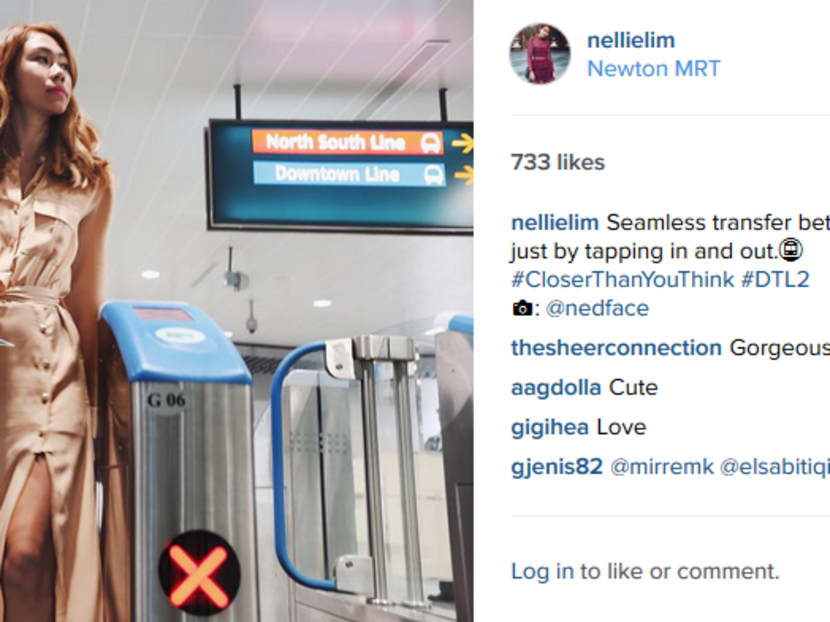NTUC, govt agencies tap star power of social media influencers
SINGAPORE — Last December, fashion blogger Nellie Lim was engaged by the Land Transport Authority (LTA) to generate some buzz for the opening of Downtown Line 2 with a glamorous photoshoot, with her Instagram posts tagged with #CloserThanYouThink for her over 40,000 followers, a move that drew mixed reactions.

A screengrab showing fashion blogger Nellie Lim's collaboration with the Land Transport Authority for the opening of Downtown Line 2.
SINGAPORE — Last December, fashion blogger Nellie Lim was engaged by the Land Transport Authority (LTA) to generate some buzz for the opening of Downtown Line 2 with a glamorous photoshoot, with her Instagram posts tagged with #CloserThanYouThink for her over 40,000 followers, a move that drew mixed reactions.
And lifestyle and travel blogger Flora Isabelle is regularly engaged by the National Trades Union Congress (NTUC) to write about labour issues, such as a blog post on the importance of skills upgrading and tripartism after she took part in a sit-down interview in January with new labour Members of Parliament Desmond Choo and Melvin Yong.
These are among the instances of government agencies and non-profit entities like the NTUC tapping social media influencers to spread key social or policy messages.
Among the organisations that have sought to ride on the reach of social media influencers are PUB, which engaged lifestyle blogger Sheila Mandy Tham for a post on how to save water while cooking, and the National Security Coordination Secretariat, which engaged travel and lifestyle blogger Jemimah Wei for a post on cyber security. Ms Tham was also engaged by the Singapore Kindness Movement to spread awareness of its volunteering initiatives in 2014.
Digital branding agencies TODAY spoke to said they were seeing more interest from government agencies on engaging influencers, as well as social media as a whole.
Depending on the number, type and duration of engagement with influencers, clients can spend between S$1,000 to S$10,000 for engaging influencers, said agencies Hashmeta and The Influencer Network, while clients with Vocanic can pay more.
The labour movement and government agencies contacted by TODAY did not respond to queries, nor did the social media influencers.
While the desire to harness the reach of social media stars comes as no surprise, industry players stressed the need to match the right influencers to the right campaign, and manage the message.
The Influencer Network director and co-founder Dennis Toh said government campaigns can no longer be “top-down”, with consumers becoming more savvy and demanding, and user-generated content and two-way communication is the way to go. “Essentially, when using social influencers, the digital brand gets ‘viraled’ into a whole new level as the social influencers repackage the messages and content into a form that is lot more personable and digestible online,” added Mr Toh, who is also an internet marketing lecturer.
But while messages relating to emotions, lifestyle, food and events are easier to communicate, more complex topics that lie outside of an influencer’s usual content are trickier to get right.
Dr Brian Lee, SIM University’s Head of Communication Programme, felt it was “viable” to have fashion and lifestyle bloggers promote some social campaigns or raise awareness of new policies, as they are individuals netizens are familiar with and can relate to. “When people are spending more time on the internet, and value more the reviews they read from the internet, getting famous bloggers to promote will make sense in terms of strategic communication,” he said.
On the other hand, Vocanic chief executive officer Ian McKee, argued that credibility of influencers in the domain or issue is key, pointing to the debacle with actress Rebecca Lim. Ms Rebecca Lim, who commands an Instagram following of some 231,000 fans, lent some of her shine to NTUC Income to promote its retirement plans — a move that backfired when some fans thought her “retirement” announcement was for real.
“The effectiveness falls off very radically when you’ve got people who are not experts in that particular domain, talking about that domain.” said Mr McKee, who also described Ms Nellie Lim’s photoshoot on the DTL2 as “wasted activation” that creates noise instead of delivering meaningful messages to the right people.
On the other hand, he gave a thumbs up to the LTA’s engagement of food blogger Daniel Ang of DanielFoodDiary, who created a post in collaboration with the LTA on interesting dining options along the train line.
There was also the possibility of the public discounting the value of the recommendation, knowing that it was procured by a brand or agency, he added.
Mr Terence Ngu, principal consultant at Hashmeta, further stressed that for social media influencers to be effective, there has to be a connection between the influencer and the message. “The key is to identify the correct influencers for the correct campaigns, which goes way beyond just getting the person with the most followers. There is this gap in ‘social media influencer’ marketing — analysing the right fit between influencer and campaign — which needs to be filled in order to maximise the money spent on a campaign,” he added.






